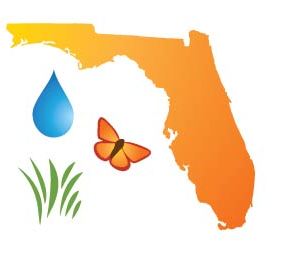
by Blake Thaxton | Sep 4, 2013

Pesticide training:
Being licensed means complying with the law – but it also means you can run your business better and smarter. The licensing course will provide you with information you will use every day – on issues like laws, safety, labeling, and integrated pest management. Even more, having a license will give you extra credibility with your clients, since they will know you have the expertise to maintain their property, and the environment, too.
Which License do I need? Try the link to figure out which license is for you. If you are still confised call your local extension agent and they will happy to assist you.
Limited Commercial Maintenance & Limited Lawn and Ornamental
- Sept 17th – Okaloosa County
- Oct. 18th – Santa Rosa County
- Nov. 1st – Escambia County (4 hours CEU license renewal only)
- Nov. 8th – Escambia County
- Nov. 19th – Okaloosa County
- Dec. 17th – Leon County
Other Pesticide trainings:
- Sept. 26th – Okaloosa County, General Standards CORE & Ornamental and Turf
- Dec. 10th – Okaloosa County, General Standards CORE & Right of Way
Green Industry – Best Management Practices (GI-BMP)
Florida Statute 482.1562 states that all commercial fertilizer applicators must have a license from the Florida Department of Agriculture and Consumer Services (FDACS) by January 1, 2014. To get this license, each Green Industry worker must be trained in the GI-BMPs and receive a certificate of completion from UF/IFAS and FDEP. Additionally, many non-commercial Green Industry applicators or other workers are required to pass the training by local ordinances or voluntarily participate in the program to better serve their clients.
- Sept. 19th – Bay County
- Oct. 1st – Okaloosa County
- Oct. 4th – Leon County
- Nov. 13th – Okaloosa County
- Nov. 15th – Santa Rosa County
- Dec. 11th – Jackson County
For Phone numbers to the County extension offices go to http://sfyl.ifas.ufl.edu/map/#map and click on the county you wish to contact.
by Carrie Stevenson | Sep 2, 2013
One of the natural phenomena I’ve loved watching this rainy summer is the dramatic “life and death” cycle of the resurrection fern (Pleopeltis polypodioides). Found most often along the branches and trunks of stately mature live oaks, this plant turns from a dry, crackly brown to a vibrant green in the span of a day.
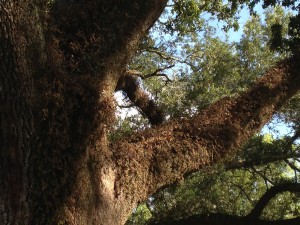
Dry, brown resurrection fern on a live oak after a period without rain. Photo credit: Carrie Stevenson
Like Spanish moss this epiphyte, or “air plant”, uses a host plant (live oak, pecan, or sabal palm) as its growing surface. Yet the fern does not damage the tree. Its root system is composed of long, winding rhizomes that tuck into the nooks and crannies of the tree’s bark, collecting rainwater and nutrients from airborne dust and nutrients leaching from the trees themselves.
The fern’s unusual response to dry weather is an adaptation that allows the fronds to curl inward, reducing water loss by decreasing surface area exposed to the elements.
Blades of turf-grass will respond similarly to drought, folding in half after several days with no water. However, the resurrection fern takes drought tolerance to a whole new level, capable of losing up to 97% of its water content without dying. As a comparison, most plants will start to die back at a 10% water loss. Several researchers estimate the fern can live 100 years in its dry state. However, true to its name, the resurrection fern will spring back to life after a rain or an increase in humidity.
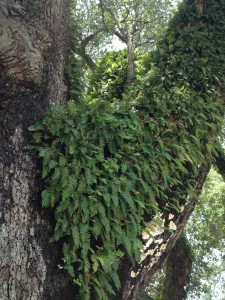
The fern that was completely dry one day will turn a vibrant green just after a rainfall. Photo credit: Carrie Stevenson
The resurrection fern has earned its place in history for several other reasons. According to literature from early pioneers and indigenous people, members of the Florida Seminole and Miccosukee tribes used the fern in baths to treat insanity. They also made a root mixture of the resurrection fern and Shoestring fern (Vittaria lineata) to treat chronic health conditions and sick babies.
Because of its unique attributes, resurrection ferns were taken in space along with the shuttle Discovery in 1997 as part of a mission to better understand natural phenomena from the perspective of space.
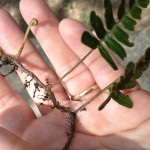
The thin, elongated rhizomes of the resurrection fern root into the crevices of a live oak’s bark. Photo credit: Carrie Stevenson
The plant is native to the eastern United States west to Texas and throughout the American tropics. A variety of the species is also native to southern Africa. It can be propagated by cutting several inches of the rhizomes and placing them into crevices of another tree, log, or rocky area. Dry fronds will respond to being sprayed with water in under an hour, so it’s also a fun experiment to show kids!
For more on resurrection ferns, check out the UF School of Forest Resources.
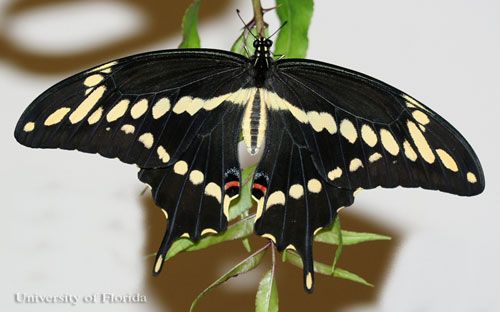
by Alex Bolques | Sep 2, 2013

Gardeners that have Satsumas, commonly known as orange mandarin (Citrus reticulate), probably have experienced a caterpillar called Orangedog. It is a chewing insect that feeds on citrus foliage including Satsuma and a few other plant species. The caterpillar is dark brown with creamy-white, mottled markings and is the larval stage of the giant swallowtail (Papilio cresphontes). It is a striking, wonderfully “exotic”-looking butterfly that is very abundant in Florida.
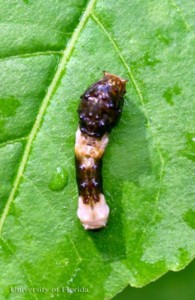
Young larva of the giant swallowtail, Illustrating bird dropping mimicry.
Credit:
Donald Hall, University of Florida
Many who have encountered the caterpillar for the first time describe them as looking similar to bird droppings. They can grow up to 1.5 to 2 inches in length and are the larval stage of the adult giant swallowtail butterfly. Established Satsuma trees can easily withstand the loss of a few leaves by Orangedog feeding. Small or newly planted Satsumas can be infested with numerous Orangedog Caterpillars on occasion, especially a single tree growing in a landscape.
A simple control measure consists of finding and crushing eggs and larva (GH-026). Bt, a biological control for most caterpillar species, is effective but should rarely be used since the beauty of this butterfly far outweighs the damage caused by them.
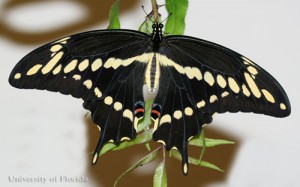
Adult giant swallowtail, with wings closed.
Credit:
Donald Hall, University of Florida
.
by Larry Williams | Sep 2, 2013
Despite the fact that winter annual weeds are not currently growing, we are approaching the best time to prevent them from being seen in our North Florida lawns.
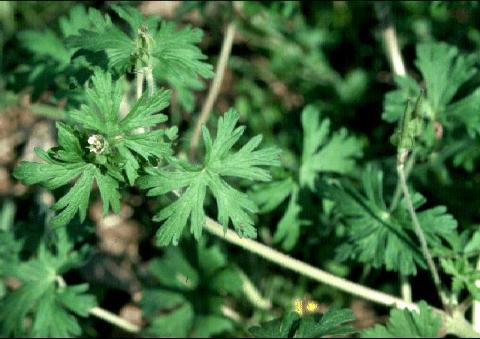
Carolina Geranium
Common winter annual weeds include annual bluegrass (Poa annua), chickweed, henbit, hop clover, lawn burweed and Carolina or wild geranium.
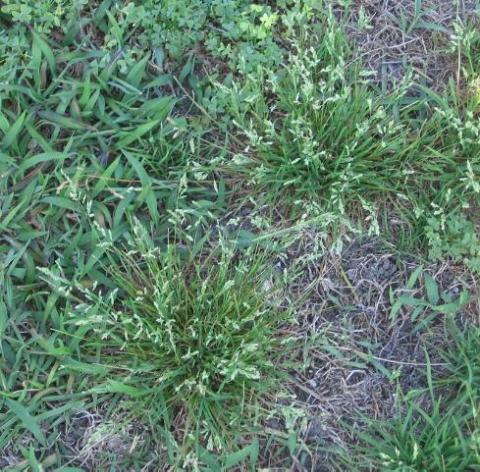
Annual Bluegrass Photo Credits: UF/IFAS
These and other winter annual weeds germinate from seeds in late fall and early winter. The little seedlings go unnoticed but continue to slowly grow through the colder winter months. Approaching spring, as day length becomes longer and soil temperatures warm, these previously inconspicuous weeds put on a growth spurt.
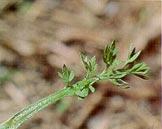
Lawn Burweed:
Close up of parsley-like leaves. Note sharp spines in leaf axils.
Photo Credits: Weeds of Southern Turfgrasses
During spring, the winter weeds may outgrow the lawn grass in our North Florida yards. They begin producing numerous flowers followed by thousands of seeds. For example, one chickweed plant can produce over 15,000 seeds.
In late spring or early summer with the onset of higher temperatures, the parent plants that started their lives from seeds the previous fall will die. But they leave behind a multitude of seed. These seed last the hot summer months dormant in your lawn. Then, in late fall and early winter, they germinate, beginning the entire cycle again.
Late September to early October, when nighttime temperatures drop to 55° to 60°F for several consecutive nights, is the time to apply a pre-emergence herbicide to interrupt the cycle of life for these winter annual weeds. This is just before seedlings emerge.
For season-long control, a second application may be needed about nine weeks after initial application. Not every lawn needs an application of pre-emergence herbicide. If your lawn has had no problem with winter annual weeds, there’s probably no need to apply a pre-emergence herbicide. Use pre-emergence herbicides only on lawns that have been established for at least a year. Many preemergence products interfere with grass seed germination. So, delay reseeding 6 to 16 weeks after application. This also applies to over-seeding a lawn with rye grass seed. Always follow label directions and precautions when using any pesticide, including herbicides.For specific pre-emergence herbicide recommendations, please consult this Weed Management Guide.
by Beth Bolles | Aug 23, 2013
We often consider the end of summer a time when nuisance insects are decreasing in numbers, but there is one insect that is reaching peak numbers at this time of year. The Stable Fly or Dog fly, Stomoxys calcitrans, can occur at all times of the year, but populations are heaviest in late Summer through early Winter along the Gulf Coast.
Resembling the common house fly, stable flies are persistent pests in their search for a blood meal. They have a painful bite due to specialized mouthparts that resemble sharp thorns that rasp the skin. Luckily, most people do not have an allergic reaction following a bite.
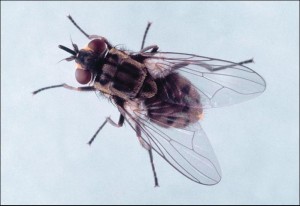
Stable flies breed in many types of moist or decaying vegetation, including seaweed deposits along the beach. Each female can lay about 500 eggs and the typical fly maggots feed in the vegetation before pupating into the adult. The entire life cycle takes several weeks.
Spraying a pesticide to control adult stable flies outdoors is not a practical option for homeowners. Rather, control methods should be directed at their breeding sites to reduce numbers. This includes allowing manures, plant debris, or crop residues to dry quickly by spreading them thinly over an area or composting them properly.
Following hurricane events, local agencies may manage stable fly populations with pesticides, but these flies do not often warrant the use of such limited resources for control.
For more information, consult this UF / IFAS publiction about the Stable Fly.












